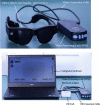An update on visual prosthesis
- PMID: 37996905
- PMCID: PMC10668475
- DOI: 10.1186/s40942-023-00498-1
An update on visual prosthesis
Abstract
Purpose: To review the available evidence on the different retinal and visual prostheses for patients with retinitis pigmentosa and new implants for other indications including dry age-related macular degeneration.
Methods: The PubMed, GoogleScholar, ScienceDirect, and ClinicalTrials databases were the main resources used to conduct the medical literature search. An extensive search was performed to identify relevant articles concerning the worldwide advances in retinal prosthesis, clinical trials, status of devices and potential future directions up to December 2022.
Results: Thirteen devices were found to be current and were ordered by stimulation location. Six have active clinical trials. Four have been discontinued, including the Alpha IMS, Alpha AMS, IRIS II, and ARGUS II which had FDA and CE mark approval. Future directions will be presented in the review.
Conclusion: This review provides an update of retinal prosthetic devices, both current and discontinued. While some devices have achieved visual perception in animals and/or humans, the main issues impeding the commercialization of these devices include: increased length of time to observe outcomes, difficulties in finding validated meaures for use in studies, unknown long-term effects, lack of funding, and a low amount of patients simultaneously diagnosed with RP lacking other comorbid conditions. The ARGUS II did get FDA and CE mark approval so it was deemed safe and also effective. However, the company became more focused on a visual cortical implant. Future efforts are headed towards more biocompatible, safe, and efficacious devices.
Keywords: Artificial vision; Retinal prostheses; Retinitis pigmentosa; Stimulation; Visual prostheses.
© 2023. The Author(s).
Conflict of interest statement
The authors declare that they have no competing interests.
Figures









References
-
- National Eye Institute: Retinitis Pigmentosa. https://www.nei.nih.gov/learn-about-eye-health/eye-conditions-and-diseas.... Accessed 6 Aug 2022.
-
- Retinitis pigmentosa: Clinical presentation and diagnosis. https://www.uptodate.com/contents/retinitis-pigmentosa-clinical-presenta.... Accessed 6 Dec 2022.
-
- Miller A. The road to visual prosthesis: a timeline. Sudbury: Technology Networks; 2022.
Publication types
LinkOut - more resources
Full Text Sources

